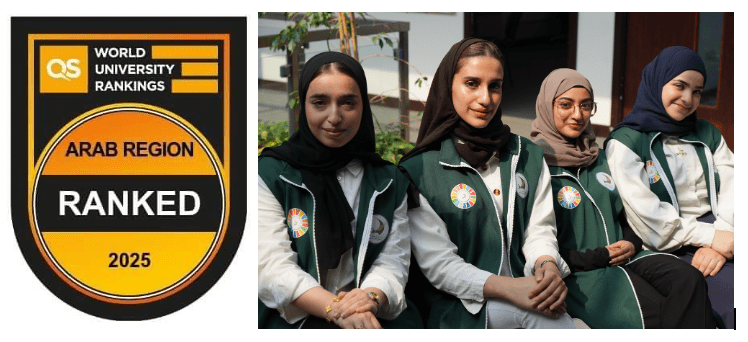The highly anticipated QS World University Rankings: Arab Region 2025 has been released today October 18, 2024, highlighting the region’s top academic institutions. For the second consecutive year, King Fahd University of Petroleum & Minerals (KFUPM) has secured the top spot, reaffirming its position as a leading university in the Arab world.
Saudi Arabia and the United Arab Emirates continue to dominate the rankings list, with three universities each making the top 10 list. Qatar, Lebanon, Oman, and Jordan also have strong representation among the region’s elite institutions.
The 2025 rankings evaluated over 246 universities (table 1) from Arab World based on 10 KPIs which are elaborate in table 2 with their weightage.
Table: 1
| Country | No. of Universities | Country | No. of Universities |
| Egypt | 36 | Tunisia | 9 |
| Saudi Arabia | 34 | Libya | 7 |
| Iraq | 32 | Oman | 6 |
| Jordan | 24 | Yemen | 6 |
| Algeria | 17 | Bahrain | 5 |
| Lebanon | 15 | Kuwait | 3 |
| UAE | 14 | Syrian Arab Republic | 3 |
| Palestinian Territory | 12 | Qatar | 2 |
| Morocco | 10 | Djibouti | 1 |
| Sudan | 9 | Mauritania | 1 |
Table 2
| Indicators | Descriptions | % Weightage |
| Academic Reputation | Measures the perception of the university’s academic quality among academics worldwide. | 30 |
| Employer Reputation | Measures the perception of the university’s graduates among employers worldwide. | 20 |
| Faculty-Student Ratio | Measures the number of faculty members per student. | 15 |
| International Research Network | Data provided by Scopus | 10 |
| Web Impact | Measures the number of times a university’s website is visited. | 5 |
| Staff with PhD. | Faculty members holding PhD. Or equivalent. | 5 |
| Citations per Paper | Measures the average number of times a university’s research papers are cited by other researchers data extracted by SCOPUS. | 5 |
| Papers per faculty | Also based on the Scopus database, this measure relates to the number of papers published per faculty member, reflecting research productivity rates. | 5 |
| International Students | Measures the percentage of international students enrolled at the university. | 2.5 |
| International Faculty | Measures the percentage of international faculty members at the university. | 2.5 |
These indicators were carefully designed by QS ranking agency to reflect the priorities and preferences of today’s students form the Arab region. By focusing on the KPIs, the QS rankings provide a valuable insight into the overall quality and impact of universities in the Arab region.
The QS ranking agency is renowned for its comprehensive suite of university rankings, providing valuable insights into various aspects of higher education. Some of their key rankings include:
QS World University Rankings, QS World University Rankings by Subject, QS Sustainability Rankings, QS University Rankings by Region, QS Global MBA Rankings, QS Business Masters Rankings, QS International Trade Rankings and QS Graduate Employability Rankings
While the QS World University Rankings (QS-WUR) offer a global perspective, the QS World University Rankings by Region is specifically designed to evaluate universities within the their region such as Arab Region ranking. This regional focus allows for a more tailored assessment that considers the unique challenges and opportunities faced by institutions in the region. The notable key differences between QS-WUR and QS-WUR (Region: Arab) are as:
- Regional Focus: The Arab Region rankings are tailored to the specific needs and priorities of universities in the Arab world.
- Indicator Selection: The indicators used in the Arab Region rankings are chosen to be more relevant to the specific context of the region, ensuring a more accurate assessment.
- Weightings: The importance assigned to each indicator may differ between the global and regional rankings, reflecting the unique priorities of the Arab region.
In conclusion, while both the global and regional rankings are published by QS, however, they serve distinct purposes and offer different insights into university performance. The global rankings provide a broader perspective, while the Arab Region rankings offer a more region-specific assessment, helping institutions understand their standing within the Arab region higher education system.
Reference:





